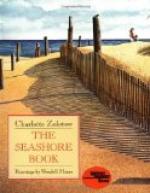Look now at the Prawn’s long, hair-like feelers. There are two pairs. On one pair are the ears, a special kind of ear for hearing in water.
You will notice that the Shrimp’s eyes are on the end of short stalks. Each big eye is really a cluster of little eyes, rather like the “compound eyes” of insects. If you lift up the horny shield behind the head, you see a row of what look like curly feathers. These are the breathing gills.
Shrimps carry their eggs about with them; no doubt you have often found masses of eggs under the Shrimp’s body. Each egg is fastened by a kind of “glue,” or else the rapid jerking of the mother Shrimp would soon loosen the eggs and set them free.
The hard, shelly covering of the Shrimp and Prawn is like the armour of the crab—it will not stretch in the least. The body is easily bent, owing to the soft hinges between the hard rings. But the coat itself will not stretch. Then how do these little creatures grow? We see small Shrimps and large ones, so grow they must, in some way.
They are of the same family—the crustacea—as the crab; and they grow in much the same way. The hard covering gets too tight for the body inside it. Then it splits across the back. After much wriggling, the Shrimp appears in a new soft skin. While the skin is still soft the Shrimp grows very quickly. Crustaceans have a funny way of growing, have they not? Instead of growing evenly, little by little, they grow by “fits and starts,” a great deal in a few hours and then not at all.
Besides being good food for us, and for the fish, Shrimps and Prawns have another use. They are scavengers. They pick to pieces and eat the vegetable and animal stuff which floats in the sea. Before it can decay and become poisonous, these useful creatures use it up as food. Great numbers of Shrimps and Prawns are caught for our markets. Some are caught by men who push a small net over the sands near shore, but most are caught by the shrimp-trawl, a large net cast from a small sailing vessel.
The rocks, and the wooden piles of the pier, are often covered with the hard shells known as Barnacles, or Acorn Shells. If you slip on them with bare feet their sharp edges cut you. Each Acorn Shell is a little house. Have you ever caught a glimpse of the animal living inside?
If you will look very carefully, you will see that the Acorn Shell is made of three-sided pieces, closely joined. There is a little door at the top, kept tightly closed until the tide comes up and covers the rocks. Then watch, and you will see a bunch of tiny feathers appear through a slit in the door. This means that the animal is hungry, and has put its twelve legs out of doors to catch a dinner!
This is strange, but true! The Barnacle is always upside down in its home, and its twelve feathery legs are thrust out of the door at the top. They make a fine net, in which minute animals are caught and brought into the mouth below. This funny creature actually kicks its food into its mouth! If you own a magnifying glass, you can see this for yourself at the seaside.




